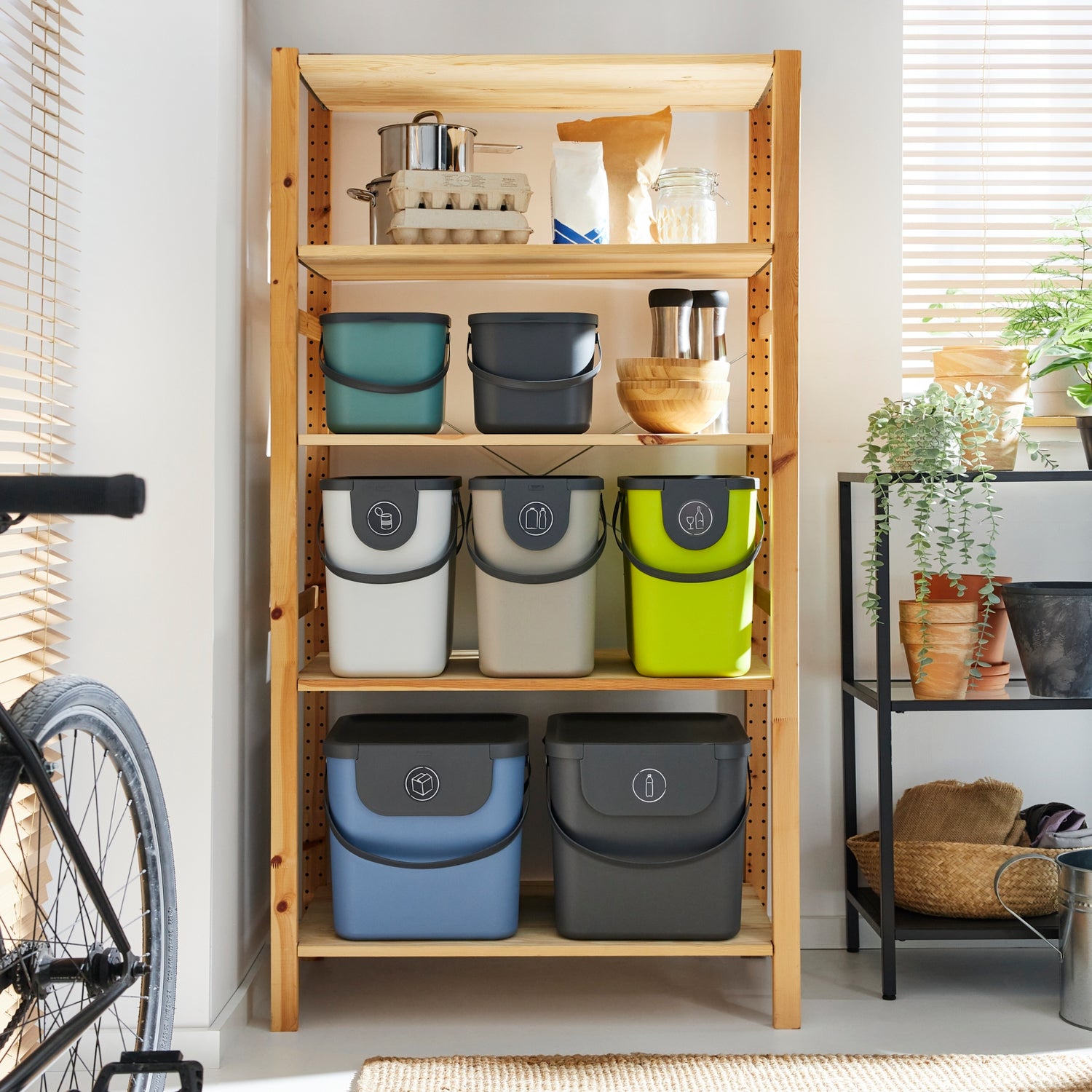There is no better time to change our daily habits than now. Implementing waste segregation is one of the most effective and simplest things we can do for our planet. Responsible waste management has a huge impact on the environment, our lives, and recycling. In this article, we will learn how to creatively incorporate waste segregation into our daily routine.
Let's get to know the diversity of waste
To begin with, let's consider the diversity of waste we are dealing with. We have mixed waste, which is made up of items that end up together in one bag and have little in common. This mix includes, among other things, plastic packaging, bio waste, metals, and plastics. However, by separating these diverse components, we can achieve many benefits for our planet and the environment. It is important that appropriate waste segregation bins are also placed in your kitchen.
Mixed waste - Is this really the end?
Mixed waste that ends up in one container poses a serious threat to our planet. Unfortunately, many of them are not suitable for recycling or biodegradation. What can we do to reduce this problem? First of all, we need to reduce the production of such waste by making wise choices while shopping.
To limit the amount of mixed waste, it is also worth implementing effective waste segregation and placing in the mixed waste bin only those items that should actually go there: leftovers from meat preparation, used oil from frying, the contents of vacuum cleaner bags, cigarette butts, receipts, broken glass and porcelain dishes, used diapers, towels and paper tissues, as well as cat litter and animal waste from the litter box.
Green waste - Natural processing cycle
Green waste, also known as biodegradable or organic waste, is an integral part of our lives. They are part of the natural processing cycle and are of great importance to our environment. It is worth knowing their proper processing and use in order to minimize the negative impact on our planet.
Our everyday life and green wasteEvery day we produce various green waste, such as vegetable and fruit scraps, peels, coffee, tea, grass clippings, or dry leaves from the garden. These seemingly insignificant wastes, when sent to landfills, contribute to the emission of methane and other greenhouse gases, which negatively affects the climate. Proper segregation of these wastes and their processing can extend the lifespan of our planet.
Every day we produce various green waste, such as vegetable and fruit scraps, peels, coffee, tea, grass clippings, or dry leaves from the garden. These seemingly insignificant wastes, when sent to landfills, contribute to the emission of methane and other greenhouse gases, which negatively affects the climate. Proper segregation of these wastes and their processing can extend the lifespan of our planet.
Segregation and recycling of green wasteThe brown container is the right place for green waste. What can we put in it? First of all, all plant residues, such as fruit scraps, vegetable waste, peels, plant stems, and mowed grass. These waste materials should be placed in special biodegradable bags that facilitate their processing.
The process of recycling green waste involves composting. Composting is a natural decomposition process, as a result of which organic matter is transformed into valuable fertilizer, rich in nutrients for plants. Using compost in gardens, parks, or even on allotments allows for the recovery of organic substances that would otherwise end up in a landfill. This helps reduce the amount of waste in landfills, which is crucial for protecting our environment.
Glass packaging - A true gem in recyclingGlass bottles and containers have an extraordinary ability to be recycled multiple times, which is why they should not end up in the regular trash bin. Proper recycling allows for a reduction in negative environmental impact. The green container is waiting for glass gems!
The brown container is the right place for green waste. What can we put in it? First of all, all plant residues, such as fruit scraps, vegetable waste, peels, plant stems, and mowed grass. These waste materials should be placed in special biodegradable bags that facilitate their processing.
The process of recycling green waste involves composting. Composting is a natural decomposition process, as a result of which organic matter is transformed into valuable fertilizer, rich in nutrients for plants. Using compost in gardens, parks, or even on allotments allows for the recovery of organic substances that would otherwise end up in a landfill. This helps reduce the amount of waste in landfills, which is crucial for protecting our environment.
Glass bottles and containers have an extraordinary ability to be recycled multiple times, which is why they should not end up in the regular trash bin. Proper recycling allows for a reduction in negative environmental impact. The green container is waiting for glass gems!
Colors of containers for sorted waste
Yellow bins - metals and plasticsThe first group is yellow bins, intended for collecting metals and plastics. In these containers, we throw in plastic bags, plastic packaging (e.g., milk cartons), plastic bottles, caps (important to throw them in separately), cans, bottle caps, metal lids, colored metals, and aluminum foil.
Blue bins - paper and cardboardBlue bins are used for storing paper. We can place books, notebooks, newspapers, magazines, leaflets, catalogs, computer prints, cardboard packaging, and paper bags in them. However, it is important not to throw in paper coated with plastic or foil, such as shiny covers or book jackets. Also, receipts, used paper towels, tissues, or paper soiled with other substances should not be placed in these bins.
The first group is yellow bins, intended for collecting metals and plastics. In these containers, we throw in plastic bags, plastic packaging (e.g., milk cartons), plastic bottles, caps (important to throw them in separately), cans, bottle caps, metal lids, colored metals, and aluminum foil.
Blue bins are used for storing paper. We can place books, notebooks, newspapers, magazines, leaflets, catalogs, computer prints, cardboard packaging, and paper bags in them. However, it is important not to throw in paper coated with plastic or foil, such as shiny covers or book jackets. Also, receipts, used paper towels, tissues, or paper soiled with other substances should not be placed in these bins.
Brown bins - biodegradable wasteThe third group is brown bins, specifically designated for biodegradable waste. Here, green waste is collected, such as bark, sawdust, branches, grass, leaves, and untreated wood. Additionally, food scraps are thrown into these bins, such as vegetables, fruits, peels, eggshells, and coffee and tea grounds. It is important to remember that ashes, cooking oils, and bones or animal waste are not considered biological waste. In some municipalities, an additional gray container is also used exclusively for green waste.
Green bins - glass bottles and containersGreen bins are dedicated to glass. Here we throw in bottles, jars, and glass containers from cosmetics. It is important that this only applies to packaging not permanently attached to elements from other fractions, e.g., plastic nozzles. Dirty containers or heat-resistant glass items must not be thrown into these bins. In some municipalities, separate containers are used for white and colored glass to facilitate further sorting.
The third group is brown bins, specifically designated for biodegradable waste. Here, green waste is collected, such as bark, sawdust, branches, grass, leaves, and untreated wood. Additionally, food scraps are thrown into these bins, such as vegetables, fruits, peels, eggshells, and coffee and tea grounds. It is important to remember that ashes, cooking oils, and bones or animal waste are not considered biological waste. In some municipalities, an additional gray container is also used exclusively for green waste.
Green bins are dedicated to glass. Here we throw in bottles, jars, and glass containers from cosmetics. It is important that this only applies to packaging not permanently attached to elements from other fractions, e.g., plastic nozzles. Dirty containers or heat-resistant glass items must not be thrown into these bins. In some municipalities, separate containers are used for white and colored glass to facilitate further sorting.
Black bins - for mixed wasteThe last group is black bins, where mixed waste is collected. In these containers, we throw away leather and fur products, used clothes, footwear, dishes, cat litter, and animal waste. Additionally, animal-origin food scraps, such as cheese, eggs, dairy, meat, and bones, should also be placed in the black bin. It is also worth remembering to put used tissues, paper towels, sanitary pads, diapers, cotton swabs, and similar items here.
The introduction of such a Common Waste Segregation System and the division of waste into colors aims to reduce the amount of waste going to landfills and increase the level of recycling, which contributes to environmental protection and the rational use of natural resources. Therefore, it is worth actively participating in segregation and properly using the available containers to collectively care for our planet.
How to get rid of construction waste?
From our experience, one of the bigger problems in waste segregation is construction waste and bulky waste.
In larger cities, there are dedicated places called problem waste collection points or selective municipal waste collection points (PSZOK). These places are specifically designated for collecting various types of waste that require special handling. We can dispose of not only rubble or old bathroom ceramics there, but also any bulky waste, such as a sofa or a wardrobe.
If we live in a housing community, we can seek assistance from the building administrator regarding the proper handling of waste. The administration usually maintains contact with a reliable waste collector who is responsible for the proper management of the collected waste.
Thanks to these waste collection points and cooperation with the building administration, we can effectively contribute to proper waste segregation and recycling, which positively impacts the environment and our shared planet.
The last group is black bins, where mixed waste is collected. In these containers, we throw away leather and fur products, used clothes, footwear, dishes, cat litter, and animal waste. Additionally, animal-origin food scraps, such as cheese, eggs, dairy, meat, and bones, should also be placed in the black bin. It is also worth remembering to put used tissues, paper towels, sanitary pads, diapers, cotton swabs, and similar items here.
The introduction of such a Common Waste Segregation System and the division of waste into colors aims to reduce the amount of waste going to landfills and increase the level of recycling, which contributes to environmental protection and the rational use of natural resources. Therefore, it is worth actively participating in segregation and properly using the available containers to collectively care for our planet.
From our experience, one of the bigger problems in waste segregation is construction waste and bulky waste.
In larger cities, there are dedicated places called problem waste collection points or selective municipal waste collection points (PSZOK). These places are specifically designated for collecting various types of waste that require special handling. We can dispose of not only rubble or old bathroom ceramics there, but also any bulky waste, such as a sofa or a wardrobe.
If we live in a housing community, we can seek assistance from the building administrator regarding the proper handling of waste. The administration usually maintains contact with a reliable waste collector who is responsible for the proper management of the collected waste.
Thanks to these waste collection points and cooperation with the building administration, we can effectively contribute to proper waste segregation and recycling, which positively impacts the environment and our shared planet.
Most common questions: FAQ
Is waste segregation really important for the environment?Yes! Waste segregation allows for more effective processing and avoids excessive environmental pollution.
What benefits does a uniform waste segregation system bring?Answer: A uniform system facilitates sorting and recycling, which leads to a reduction in the amount of waste going to landfills.
Yes! Waste segregation allows for more effective processing and avoids excessive environmental pollution.
Answer: A uniform system facilitates sorting and recycling, which leads to a reduction in the amount of waste going to landfills.
MPSZOK, GPSZOK and PSZOK - What is it?All three refer to the same place. PSZOK is the Selective Collection Point for Municipal Waste. It is a specially organized place for the residents of the municipality where they can leave municipal waste, especially those that should not be thrown into home containers and bags. M or G at the beginning of the abbreviation stands for Municipal or Community Point.
Where to throw away the dirty jar?You can throw the jar after mayonnaise or jam into the glass container. You don't have to wash it, just make sure to empty it well. Remember to throw the lid into the yellow bin for metals and plastics. A broken jar should also be thrown into the glass.
All three refer to the same place. PSZOK is the Selective Collection Point for Municipal Waste. It is a specially organized place for the residents of the municipality where they can leave municipal waste, especially those that should not be thrown into home containers and bags. M or G at the beginning of the abbreviation stands for Municipal or Community Point.
You can throw the jar after mayonnaise or jam into the glass container. You don't have to wash it, just make sure to empty it well. Remember to throw the lid into the yellow bin for metals and plastics. A broken jar should also be thrown into the glass.
Together we change the world!
Thanks to our creative efforts and a unified waste segregation system, we can truly change our planet. Small changes in our daily habits can bring huge benefits to the environment. Reducing the amount of waste going to landfills, increasing recycling and reprocessing - all of this will contribute to creating a better, more eco-friendly world for us and future generations.
Let us remember that waste segregation is not only our individual responsibility but also a common goal that we will achieve together. Through simple actions like proper segregation, each of us can become a hero of our planet.
It is worth starting right now. Let our effort be like a light in the tunnel that illuminates the way for future generations. It’s time to act!





